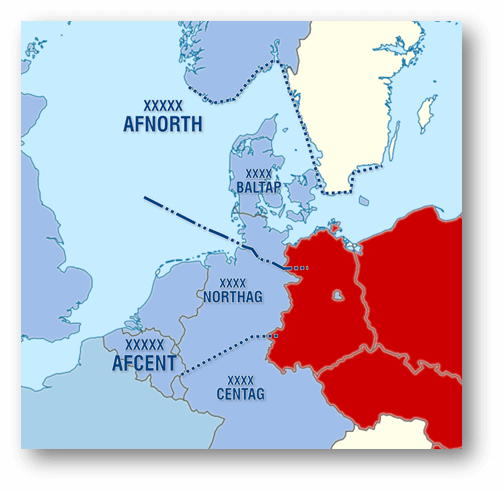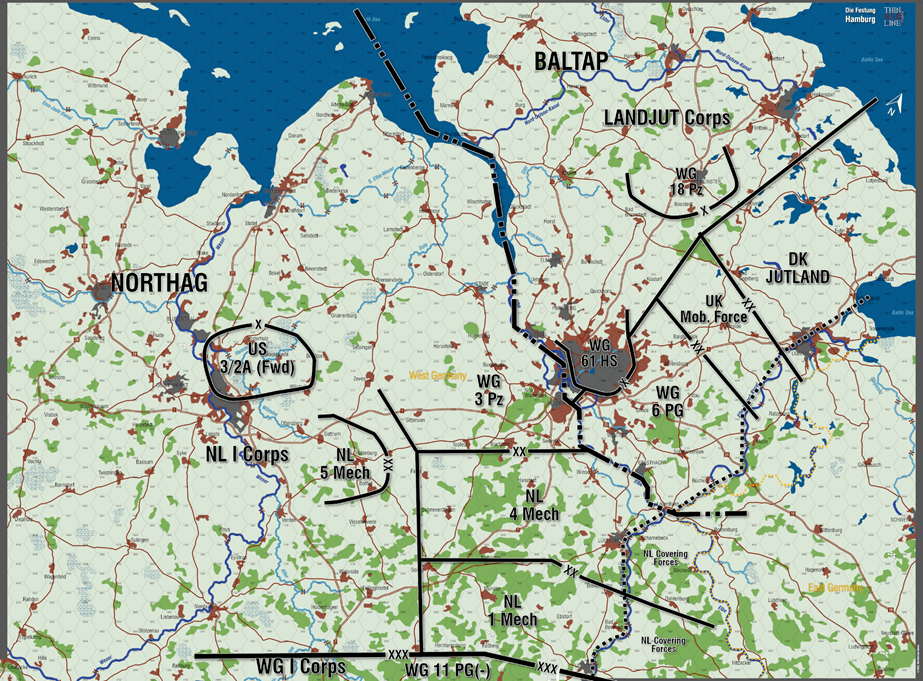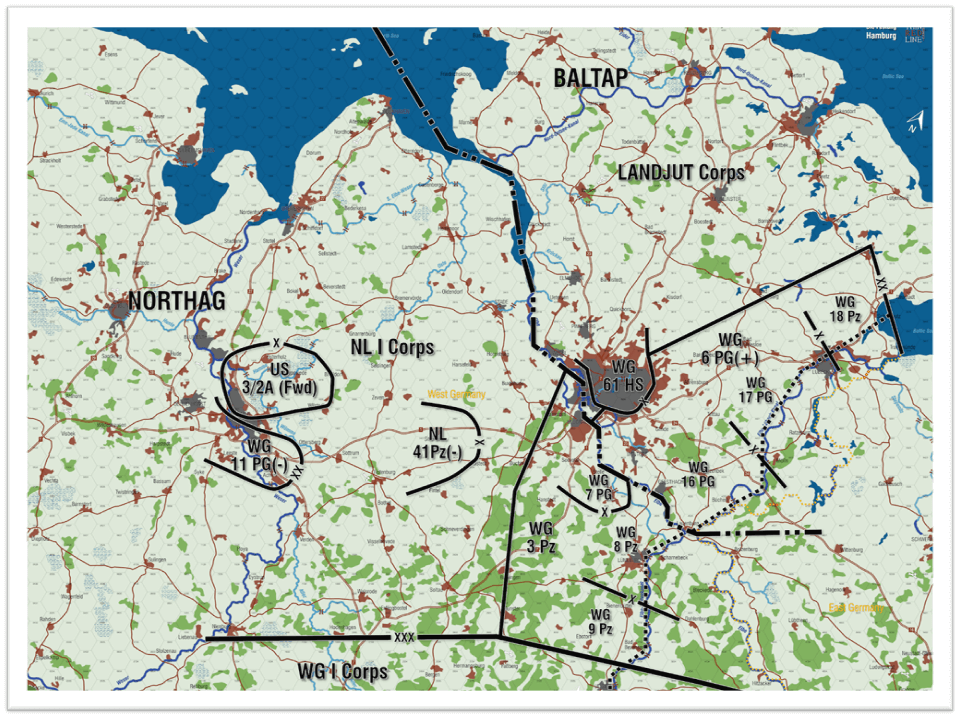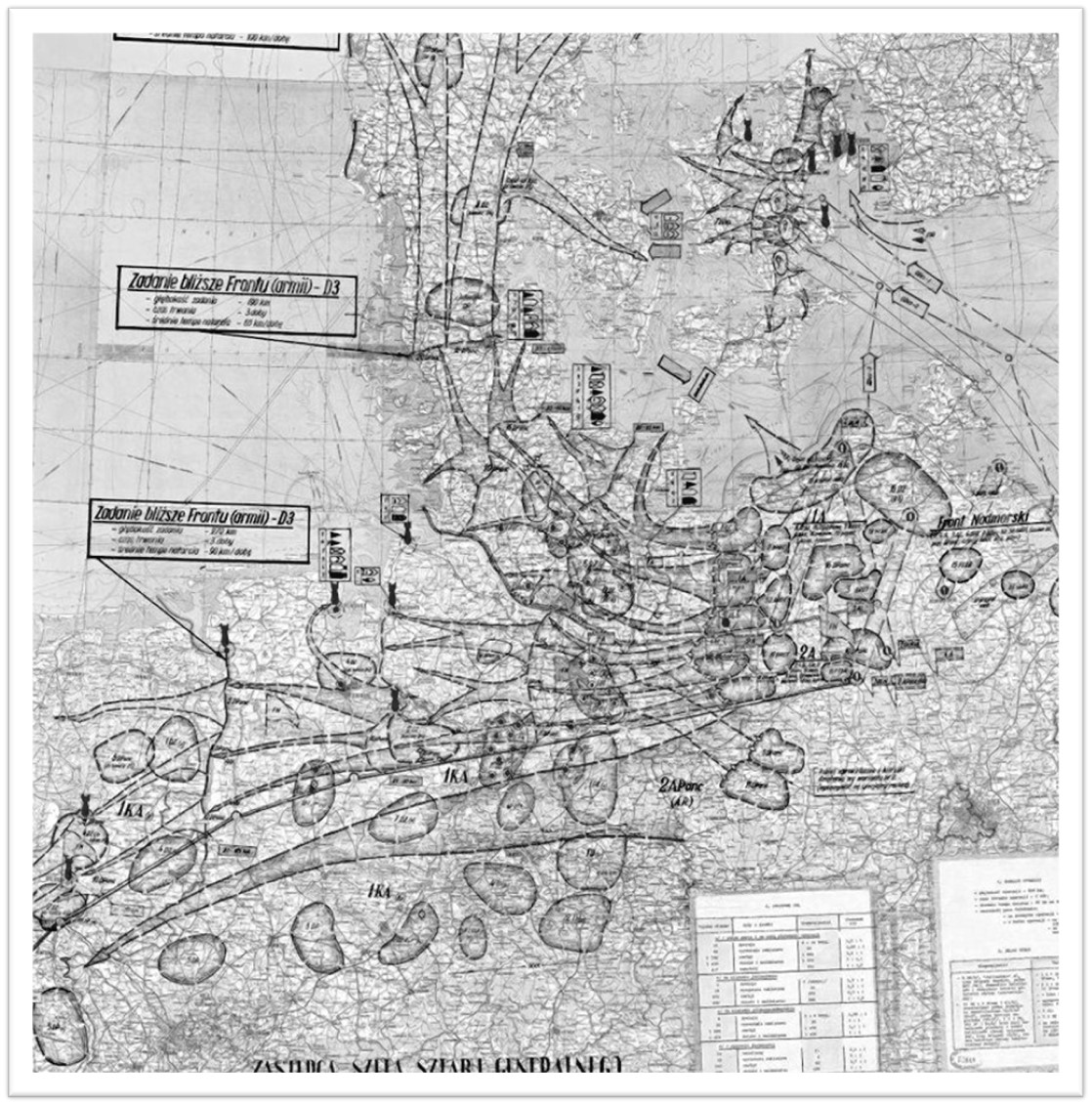Die Festung Hamburg introduces a new depth to the problems and challenges that both NATO and Warsaw Pact must face, despite having only small changes in the rules used by Less Than 60 Miles and The Dogs of War.
In the following pages we (the development team, not a majestic plural) will cover the causes of these problems, and their consequences. For those interested in a broader overview of the system, I suggest downloading the Less Than 60 Miles Extended Designer’s Notes available on TRLGames.com. They are probably worth a look if you have never read them.
NATO and the North German Plain
The map covers two different NATO high-level Commands:
● The lower half of Allied Forces Baltic Approaches (BALTAP), under command of the Allied Forces Northern Europe (AFNORTH).
● The upper half of Northern Army Group (NORTHAG), under command of the Allied Forces Central Europe (AFCENT).

As explained in the rules, the AFNORTH – AFCENT boundary has a strong impact on NATO operational capabilities.
Professional military are obsessed with boundaries for several good reasons, as they help solving critical problems but also create dangerous weak points, as Anthony will explain later. For now, just keep in mind that innocent-looking dotted line running along the Elbe river.
Now, let’s take a look to the forces NATO had at its disposal to stop the Communist Hordes.
Kremlin Called, They Are Going to Invade Next Monday
In NATO best-case scenario, Moscow’s intentions are discovered and correctly interpreted well before the beginning of hostilities, giving NATO several days to mobilise and deploy its forces. At D+0, the sector would have had the following major formations combat-ready:
● LANDJUT Corps, with one West German Panzergrenadier division, one Danish mechanized division, one high-quality West German Territorial Brigade, extra artillery and engineers, and the UK Mobile Force.
● Netherlands I Corps, with three Dutch mechanized divisions, one West German Panzer division, and one US reinforced brigade.
● Northern section of West German I Corps, with a reduced West German Panzergrenadier division.
As you can see from the map, the sector looks well defended: The main defence line is protected by wide water obstacles, West German I Corps is barely involved, and strong reserves are available for facing any possible development.

The Requested Corps is not Available at the Moment
In an almost-worst-case scenario, Western countries finally agree on the critical Transfer of Authority to NATO only a few hours before the beginning of the Warsaw Pact offensive.
As already stated elsewhere (see The Dogs of War Designers’ Notes), surprise has been far from uncommon in the history of warfare, continues to happen even in modern battlefields at varying degrees, and has always unpleasant consequences for the surprised side. NATO would have been particularly vulnerable on this, as any significant military move required an unanimous political decision and a transfer of authority from the political branch of the single member states to the NATO centralised command.
The consequences of this vulnerability have been applied to NATO in the whole C3 series, and this means particularly big troubles in the North German Plain sector: Dutch and Danish armies are mostly formed by recalled reservists, and the peacetime deployment of most forces is abysmally far from being optimal (Again, Tony’s notes will dive deeper into these aspects).
In practical terms, a NATO suffering operational surprise would have had only the following forces more or less ready when the first Soviet tank crosses the Inner German Border:
● In LANDJUT Corps sector, one reinforced West German Panzergrenadier division.
● In Netherlands I Corps sector, one West German Panzer division and one reinforced US brigade.
● In West German I Corps sector, one West German recon battalion (for inscrutable reasons, the two brigades from WG 11 PanzerGrenadier Division are stationed on the North Sea).
This would have forced NATO to adopt a completely different General Defense Plan:
● West German 6 PanzerGrenadier Division defending the whole LANDJUT Corps AoR.
● West German 3 Panzer Division defending the whole Netherlands I Corps AoR
and the Northern section of the West German I Corps AoR.
● Dutch 41 Panzer Brigade moving to the front line but not yet in its assigned area.
● US 3/2A (Fwd) Brigade possibly acting as an additional covering force.
Bottom line: Until the arrival of the Dutch (not before D+2) and Danes (D+1), the situation for NATO would have been extremely critical.

We Are Currently Experiencing Problems – Please Bear With Us
NATO was well aware of the problems created by the mal-deployment of Netherlands I Corps and by its dependency on a timely mobilisation, and from 1977 tried to convince the Dutch government to move into West Germany at least one additional brigade and the Corps’ command staff. Some half-measures were taken, but none of them would have really helped in the case of a Warsaw Pact surprise attack.
In July 1985, a new operational plan was finally implemented: The following units would have acted as covering forces in the Netherlands I Corps Area of Responsibility, hopefully gaining enough time to allow the three Dutch divisions to reach the battle area:
● Dutch 103 Reconnaissance Battalion
● Dutch 41 Pantser Brigade
● West German 3 Reconnaissance Battalion
● US 3/2A (Fwd) Brigade
The role of the US 3/2A (Fwd) Brigade was the subject of particularly nasty discussions during development. Originally conceived as the forward element of US III Corps, there were two different interpretation of its possible role in wartime:
● As the forward element of US III Corps, it would have defended the Bremen / Bremerhaven area until needed, then moved Westward to join the AFCENT theatre reserve (US III and French III Corps).
● As one of the few formations available in case of surprise attack, it would have taken the role of covering force until needed, then moved Westward to join the AFCENT theatre reserve (US III and French III Corps).
After endless research and discussion we decided to ask directly to the brigade veterans, and their unanimous answer was that the brigade planned and trained to act as a covering force. Some of them also pointed out, contrary to our initial evaluation, that the brigade had an augmented logistic support to allow fighting alone for a limited period.
All of the above was probably not completely operational by the time of our events, but at least the basics had been defined. Would have been enough? Well, you will discover it by yourself.
Guns or Tulips? The Case For Tulips
Another hot discussion during development was about the proficiency and will to fight of the Royal Netherlands Army. As the main supporter of the “Tulips” party, it is my duty to list some of the facts that brought to the not particularly exciting Dutch cadre value:
● Several of our main sources (RAND and Isby’s “Armies of NATO Central Front”) have a quite negative evaluation of both the training and the will to fight of the Dutch Army.
● 1985’s Dutch Army was 80% mandatory conscription. I’ve served in a conscript army, and what I’ve noticed is that, unless there’s some additional motivation like defending your home or risking an execution squad, the average conscript lives the year or more of military service as a boring, useless waste of time. He will simply try to avoid any problem – let alone dying – until it’s over.
● 1985’s Dutch Army had the biggest trade union in the world open to any military grade and service (VVDM). VVDM included 60% of the conscript soldiers as members at its peak, and Trotskyist and Maoist fringe movements. Some of the VVDM requests were abolish reveille at 6.00 AM, abolish corvee, right to strike, and weekend free movement replaced by weekend leave.
In conclusion, was the 1985 Dutch Army trying to move past the lows of the 70s? Absolutely. Had it become an above-average army of hardened warriors? Not at all, or maybe not yet.
Warsaw Pact Forces
In the strategic scenario used for the C3 series, Warsaw Pact has considerable forces to commit to the Hamburg – Jutland sector, even though it is possible that STAVKA would assign some of them to other operations:
● Assigned to Northern Front
Soviet 2nd Guards Tank Army (1x Tank, 3x Mot. Infantry divisions)
Soviet 38th Guards Landing-Assault Brigade
East German 5 Army (1x Panzer, 1x Mot. Infantry divisions)
Polish 1st Army (2x Armored, 2x Mech. Infantry divisions)
● Assigned to Northern Front or West Berlin operations
Soviet 20th Tank Division
East German 5 Army (1x Mot. Infantry division)
Polish 2nd Army (1x Armored and 1x Mech. Infantry division, remaining two divisions to West Berlin)
● Assigned to Northern Front or Norway operations
Soviet 76th Guards Airborne Division
If you are wondering where the third Polish Army (Warsaw Military District) is, the answer is “in Poland”. The political and social turmoil caused by the Solidarnosc movement was far from being quelled in 1985, and Jaruzelsky’s government would have needed a strong garrison on the national territory to keep control, particularly during a global conflict with the West.
In total, Warsaw Pact could have at his disposal from 10 to 15 divisions, but committing all of them to North Germany would probably bring to a halt the operations in West Berlin and slow down the advance in Norway. So, the Front Commander must take several decisions about the forces he is going to request, and each decision will have consequences on the results the Politburo expects from him.
Moreover, Northern Front Commander must deal with three critical problems: The split axis of advance, the water obstacles, and the troops quality.
Split Axis of Advance
The Northern Front has two completely different strategic objectives to fulfil: Advance westward in Northern Germany up to the Netherlands border, and advance northward in the Jutland peninsula to “liberate” continental Denmark.
Both these axes of advance require significant forces and cannot mutually support each other, thus forcing the Front Commander to split the available resources between the two.
In one of the few Warsaw Pact plans publicly available, the Jutland offensive was entrusted to the Polish forces alone. However at the time of that plan (early 1970s) the WP ORBAT had the Polish Forces with 3 complete armies and the command of at least one operational direction, leaving the Northern Front Commander the whole of his Soviet forces and the East Germans to deploy as he saw fit. Jaruselzski officially withdrew Poland from that task in 1981, leaving one or possibly two armies available under Northern Front command.
Therefore there is but a single Front Commander who has relatively substantial forces but diverging tasks. He could find getting the balance right to achieve both well beyond his capabilities.

Water Obstacles
The terrain in the area of operations is generally good for a mechanized offensive, with two relevant exceptions: urban areas and water obstacles. Urban areas are a common problem in the whole West Germany, so let’s talk about rivers and canals more in detail.
The Jutland offensive axis will have to deal immediately with the Elbe-Lübeck Kanal and with the Nord-Ostee Kanal later, while the Bremen offensive axis must find its way across the Elbe, the Elbe-Seitenkanal and the Weser. All of them are significant water obstacles requiring difficult attacks, lots of engineers, and probably a lot of time.
From a technical point of view, the most interesting of these water barriers is the Elbe-Seitenkanal. Despite being only 50 meters wide, it was built to maximise its effect as an obstacle for armored troops advancing in a east-west direction, with its embankments having angles specially studied to make fording almost impossible, no matter the horse power or the amphibious capabilities of a vehicle.
Each water barrier could need 3 to 6 hours of heavy fighting just to establish a bridgehead on the opposite bank, plus 6 to 9 hours to build a decent bridge in order to cross in force. Of course, unexpected circumstances are not accounted for, as there’s none in the Socialist scientific approach to warfare.
Luckily for the Soviet Front Commander, NATO will probably not have enough troops to defend all the crossing points on the Inner German Border, and the 38th Guards Land-Assault Brigade can be a decisive factor to overcome at least one of the obstacles during the first, decisive hours.

Our Trusted Socialist Brothers
The third problem that Warsaw Pact must face is about the allied troops, forming at least half of its forces.
The East German Nationale Volksarmee (National People’s Army) was quite well-trained, even though the average soldier would have been not too happy to die fighting other Germans for the Socialist Cause. If you are unconvinced, please remember that from 1950 to 1989 four millions East Germans fled to the evil and hatred Western Europe, causing a net population decline from 18.4 to 16.4 millions when including deaths and births and forcing the regime to build the barriers system along the Inner German Border.
East German equipment was below the Soviet standard: The T-55 was still the dominant main battle tank, and in 1985 considerable efforts were being made to upgrade artillery battalions from towed to self-propelled.
The Polish Ludowe Wojsko Polskie (Polish People’s Army) was in even worse conditions for several reasons.
First of all, fielding thirteen division was definitely too much for the declining Polish budget, forcing the army to keep in service T-54, T-55 and a vast array of towed artillery dating back to the Second World War.
Second, the rise of the Solidanorsc free union, its subsequent suppression by the regime and the declaration of martial law in 1981 sanctioned the definitive separation between the Polish society and the Communist regime. The fact that Solidarnosc reached 10 millions members, one third of the total Polish population and three times the members of the Polish Communist Party, gives the measure of how enthusiastic the support would have been for a war in West Germany ordered by the Kremlin.
As a final note, the tank regiment in both the Polish and East German Tank divisions does not include a Motorized Infantry battalion as its Soviet counterpart, making them less effective when used against infantry in a favourable defensive position.
Despite all of the above, East German and Polish forces should not underestimated; As General Franz Halder once said about the Soviets: “Their units were not armed and trained in the way we would consider them, yet they were there”. Particularly in the first hours of war, the mocked East German and Polish towed artillery can deliver a brutal effect on the NATO forces deployed near the Inner German Border, up to the point of practically destroying any unit not properly prepared for it.
Firstly lovely article, secondly big favour and probably not possible
I am writing a large scale set of rules for 6mm with 1 bn being standard unit, whilst I am developing it I chose the LANDJUT Corps sector set in 1982 (mostly because 6th Pz still had some M48s), and am trying to design a map (with not much success as art skills are not my forte as even during rule development I want historical games, so essentially the favour is to have a copy of the map from east of the elbe to far north ie LANDJUT Corps Sector
You need to talk to the designer and publisher. That is Trademarked and proprietary. So The short answer would be no.